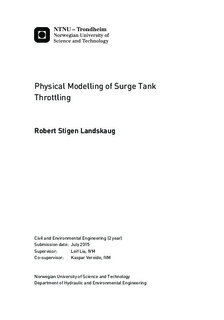| dc.description.abstract | The scope of this master thesis is to design a surge tank throttle based on literature values, and compare the expected head loss factor with the results from a 3D numerical simulation, and a physical model test. A literature review on throttle effects and the state-of-the-art throttle design will also be carried out as a part of the thesis. As a supplement to the thesis scope, the hydraulic effects of installing the throttle in the physical model will be discussed.
The literature review reveal that a throttle has a high influence on the dampening of mass oscillations in a hydropower plant. In addition, a properly designed throttle lowers the volume demand of the surge tank, improves the governing stability for the machines, and reduce the maximum pressure in front of the turbine.
The 1D numerical program LVTrans is used to calculate the hydraulic transients in the whole system and the 3D numerical program STAR-CCM+ is used to calculate the throttle head loss. The physical model used in this work is a 1:65 scale model of Torpa hydropower plant constructed at the Norwegian University of Science and Technology (NTNU).
The load case for the experiments is a multiple closing and opening case to get resonance and bring the system to the maximum possible state of oscillations, which is a method used in Austria since the 1960s. The throttle design tested in this work is an asymmetric throttle with a relatively simple design, to reduce construction time and cost. The main parameter for the throttle design was found to be the smallest diameter. Two surge tank throttles with different diameters were made and used to compare the different methods.
The literature values underestimate the head loss coefficient in both directions compared to the physical model test. The literature values show acceptable correlation to the physical model test in the upward direction, which is the direction with the simplest hydraulic conditions. The conditions in the downward direction are more complicated, and this is also reflected in the results, where the difference is larger.
The 3D numerical simulations give results that are lower than the physical model test for downward flow, and higher for upward flow. The numerical simulations give the highest ratio between head loss in the upward and downward directions.
The findings also shows a significant impact on the pressure development and dampening of mass oscillations by inserting a surge tank throttle, as was found in the literature review. The two throttles tested in the physical model reduced the maximum pressure by 5.2% and 3.9% for the smallest and largest throttle diameter respectively. This was with the use of the scaled maximum discharge from the prototype. | |

